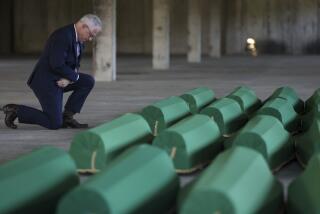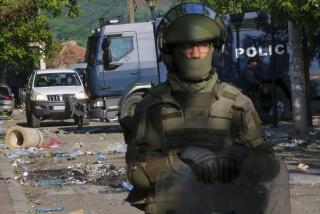New Conflict Mirrors Prelude to Kosovo War
- Share via
DOBROSIN, Yugoslavia — While NATO-led troops struggle to keep the peace in Kosovo, a new guerrilla war between ethnic Albanians and Serbian forces is brewing just across the border.
A rebel band of about 150 ethnic Albanians has a foothold in this nearly deserted village in southeastern Serbia, about 300 yards from a U.S. Army camp guarding a muddy track that leads into Kosovo.
The guerrillas carry AK-47 assault rifles and walkie-talkies, and wear camouflage fatigues or black uniforms and berets. They look a lot like members of the separatist Kosovo Liberation Army, which was formally disbanded after NATO took control of the province last summer.
At first glance, the red, black and gold patches on the guerrillas’ uniforms appear to be KLA insignia, but a closer look reveals the unwieldy name of Yugoslavia’s latest fighting force: the Presevo, Medvedja and Bujanovac Liberation Army.
The rebels take their name from the three main towns in an area that is mostly populated by ethnic Albanians and located in Serbia proper, just east of Kosovo’s provincial border. The rebels’ commanders acknowledge that many of them are former KLA fighters. The Serbs see them all as “terrorists.”
The current conflict sounds uncannily like the early days of one in Kosovo that ended with NATO’s 11-week bombing campaign last year: Serbian repression spawns a small, village-based guerrilla army, whose attacks on Serbian forces provoke vicious reprisals. As survivors sign up to fight for the guerrillas, villages are emptied and sometimes burned. Civilian casualties mount, along with cries for foreign troops to intervene.
The North Atlantic Treaty Organization insists that it is trying to avert another conflict, but as the number of ambushes, bombings and assassinations increases, isolated skirmishes threaten to escalate into another war.
Knowing that Serbian police might attack at any moment, the rebels here refuse to be photographed, or even have their voices recorded, in case it can be used to convict them on terrorism charges. Their commander, a harried-looking man of middle age in civilian clothes, hasn’t chosen a nom de guerre yet, so he suggests that reporters call him “the officer.”
“Every day the repression is growing, and every day more volunteer fighters are coming,” he said Friday in the second-story bedroom of a farmhouse that serves as the rebels’ headquarters.
“A big majority of the youth are now ready to take up arms to defend their families, their honor and their land because this is Albanian land,” he added.
Just two years ago, Serbian police ignited a full-scale war in Kosovo with a brutal attack on KLA hero Adem Jashari’s home base in the village of Prekaz in the central Drenica region. The assault killed 46 people, including 11 children between the ages of 3 and 10.
Guerrillas Seek to Liberate 3 Towns
Despite the presence of the NATO-led KFOR peacekeeping force, Kosovo technically remains a province of Serbia. The new battleground in Serbia proper is in a 482-square-mile zone that ethnic Albanians claim is historically part of Kosovo.
Before NATO’s air war against Yugoslavia began last March 24, more than 100,000 ethnic Albanians lived in southern Serbia, but a steady exodus in recent months has reduced that number to an estimated 75,000.
Western governments had hoped to protect thousands of ethnic Albanians outside Kosovo’s borders by creating a 15-mile-deep buffer zone in Serbia proper where Yugoslav police and army units could not patrol. But during talks last summer to end the air war, NATO compromised and agreed to a buffer zone only three miles deep.
Ethnic Albanians consider that one of the most serious mistakes NATO made in the truce negotiations.
Dobrosin, just a few hundred yards from the Kosovo border, is within the three-mile zone, and it is relatively peaceful.
Sentries look down on the area from a watchtower inside the U.S. post, which is surrounded by barbed wire, razor wire and tank traps. At least one tank and several other armored vehicles are parked facing the Serbian countryside.
But Presevo, Medvedja and Bujanovac, the towns the ethnic Albanian guerrillas hope to liberate, are outside the three-mile zone.
KFOR officials pledge to keep the violence in Kosovo from spreading.
“What we are doing is to try hard to prevent this export of violence--this potential export of violence--by controlling the border very, very strictly,’ KFOR spokesman Henning Philipp told a news conference Wednesday. “We are aware of some people in groups who are aiming at destabilizing the situation in the Presevo valley.”
Ethnic Albanians began fleeing southern Serbia soon after the arrival of police and army units withdrawing from neighboring Kosovo last June, and reported many cases of harassment, the bombing near a school and even killings.
But Serbian officials say the trouble started Nov. 16, when ethnic Albanian Sefket Hasani, who had returned to Dobrosin after working in Switzerland, fired on a police patrol. The village’s rebel commander acknowledges that Hasani, 54, once shot at Serbian police, but says that it was because they tried to capture him as a suspected KLA fighter.
Under police pressure, the villagers ordered Hasani and several followers to leave, according to Dr. Stojanca Arsic, Serbian mayor of nearby Bujanovac. But by Jan. 26, they had returned--this time in uniforms.
One Serbian police officer was seriously wounded in a firefight that erupted. Two ethnic Albanian brothers who were out cutting firewood were killed.
Arsic says the dead Albanians were “decent people” caught in the cross-fire. But the rebels holed up in Dobrosin on Friday claim that the men were executed with bullets to the back of the head by Serbian police.
Crackdown by Police Amid Wave of Attacks
The region around Medvedja has suffered the worst. Most ethnic Albanians have abandoned their homes and fled to Kosovo or neighboring Macedonia, says Riza Halimi, mayor of Presevo, a mainly ethnic Albanian town.
Although tensions have eased in Presevo, Serbian Interior Ministry police veterans from Kosovo have poured into the region, Halimi says.
“They came in camouflage uniforms, with machine guns and bulletproof vests,” Halimi said. “They patrolled villages and inspected taverns in full combat gear--with more men watching their backs with loaded guns.”
The police crackdown comes amid a wave of bombings, attacks against police and assassinations of ethnic Albanians considered loyal to the Serbian government.
In Bujanovac, there were four blasts from plastic explosives in February, one near an elementary school, two in a Gypsy neighborhood and the fourth next to a movie theater that was showing the film “The Sixth Sense.” On Feb. 26, the day after the fourth blast, the Dobrosin commander says, his guerrillas stumbled upon a civilian van loaded with Serbian police.
They attacked, killing a police major. Three other officers were seriously wounded.
Arsic, the mayor of Bujanovac, lays some of the responsibility with U.S. troops along the border.
“The American KFOR troops can do the most to solve this problem because they are the ones who are controlling the border through which the ‘terrorists’ cross. If they close that border, everything will be OK,” he said.
Arsic expects the fighting to escalate in the area when the NATO-led peacekeeping force in Kosovo begins military maneuvers later this month, which the mayor thinks the rebel fighters may use as cover.
“They are probably going to cause a major incident soon,” the mayor predicted. “We could easily deal with them by force, but that might have larger implications, which are in nobody’s interest.”
*
GENERAL SENTENCED
A Bosnian Croat officer receives U.N. tribunal’s harshest term yet: 45 years. A10
More to Read
Sign up for Essential California
The most important California stories and recommendations in your inbox every morning.
You may occasionally receive promotional content from the Los Angeles Times.













